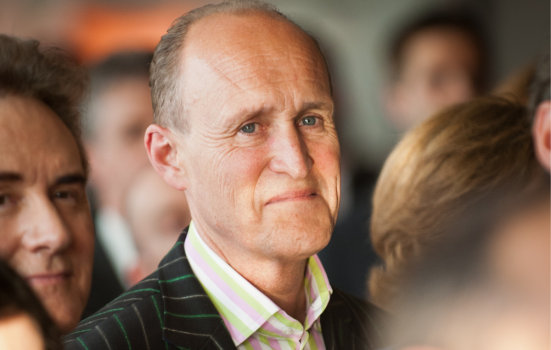Following the publication of the Creative Industries Sector Vision, Peter Bazalgette, who advised on its content, speaks to Arts Professional’s Neil Puffett about the impact it will have.

Financial Times/Creative Commons
The Creative Industries Sector Vision sets out how government and wider industry plans to grow the economic value of the sector by £50bn by 2030. It pledges to strengthen the creative talent pipeline, facilitate joined up thinking across government departments and improve the creative industries’ position in the UK’s research and development ecosystem, which Peter Bazalgette, co-Chair of the Creative Industries Council, hopes will lead to increased research funding for the sector in the future.
A long-awaited vision worth waiting for
Neil Puffett (NP): I bet you are pretty happy that the vision has finally been published.
Peter Bazalgette (PB): Yes, it's true that it could or maybe should have been published earlier. And that wasn't easy. [The delay] is true of most government departments in the last few months because there's been rapid changeover. But I have to say the delay in publishing it has made it a better document. Every cloud has a silver lining.
NP: In what respect is it a better document?
PB: It’s just more thorough, more thought through, better consulted, more input for all the different subsectors. In particular, if it had been published a year ago or nine months ago or six months ago, it would not have had the support it's had from [Chancellor] Jeremy Hunt.
You've seen those spending commitments: the second phase of Creative Clusters, the CoSTAR investment - which has got £63m in private money as well as £75m in public money - the UK Games Fund investment, the Grassroots Music Fund investment, the Create Growth investment, the Music Exports Growth Fund investment, the London Fashion Week investment and the London Film Festival investment.
Those are new things that the Chancellor has added. He really wanted to get behind it. I think partly because he gets the creative industries. They're a priority sector for him. And he was the DCMS Minister 10 years ago. I think it's made it a better document and it's had more support from government than it would have had earlier.
Investment in the creative sector 'a step forward'
NP: When you look at the figure of £77m announced last week, in terms of government spending that's not a huge amount of money.
PB: Look, it is undoubtedly the case that we're on a journey to get the creative sector as favoured and as recognised in terms of investment, not just from the government, but trade investment as well. We want to get it as recognised as other sectors like life sciences.
The thing I now argue is that we are as much a research and development-led innovation sector as any other growing sunrise sector, but we're not necessarily recognised as that. And we don't get so much of a share of the research cake, but this is a step forward here.
The £77m is worth having, particularly the investment in the second clusters. But if you include the private money that's going into CoSTAR, and existing support, it's more than that. The CoSTAR project that the Arts and Humanities Research Council is doing, which is next generation screen technologies, has received £75m of public money.
Now, admittedly, that was already announced, you can't call that new money, but it is money going into the sector. What is new is the private sector is matching that with £63m. If you put the £50m and the £63m and the £75m together, [the government] were downplaying it slightly. It's actually better than it sounds.
Distinguishing the vision from the Arts Council
NP: Museums, galleries, libraries, performing and visual arts, they're one of the nine subsectors of the creative industries as defined by DCMS. But there appears to be very little for them in this vision in terms of support. Why is that?
PB: Well, I think there's plenty of support for the performing arts if you include music in that. There's a lot about music. [But] this document is not the Arts Council. This document is about growing the whole sector.
The performing arts are critical because they develop a lot of the talent that flows into the commercial sector, not just in theatre, but in all sorts of other publicly supported arts. They develop talent that creates commercial value later in the commercial sector. But the job of this is not to fund publicly supported arts. That's what the Arts Council does and the direct funding for galleries and museums does, and indeed, the Covid Recovery Fund. The job of this is to put an economic lens on the sector.
[The vision] has got a lot to do with skills and a lot to do with career pathways. Now, I would refer you to the skills section [of the vision]. We need to do better in all fields of the creative sector, including arts and culture, in getting more people in from more communities and more backgrounds into jobs in the sector. The elements on career pathways are about us defining the career pathways into the sector. And that does include the publicly supported arts.
The other thing I'd refer you to is the third section - the impact section – which features social prescribing. I was very hot on that when I was [Chair] at the Arts Council myself, which was now a few years ago.
I remember ahead of the 2015 general election trying to get the politicians interested in social prescribing and only the Liberal Democrats listened to me. Unfortunately, they went from 65 seats to eight seats, so that didn't go very well. But now they're all interested in it, so that's very relevant to arts and culture, too.
Developing the creative industries 'ongoing work'
NP: Earlier this year, the House of Lords Communications Committee published a report warning that the creative industries are “at risk” because of government complacency. One of the concerns was a lack of joined up cross-departmental thinking and action. Do you think this vision addresses that? Do you think it has cross-departmental buy-in?
PB: I think it's a serious step in that direction. The pledge to put £50m into creative clusters is money that will go in via UK Research and Innovation which sits under the Department for Science, Innovation and Technology (DSIT), not under DCMS. Then there are lots of pledges about increasing exports of our products and services from creative industries, and exports comes under the Department of Business and Trade (DBT). So all of those departments had to step in.
I think the House of Lords report had a fair point to make, that historically we haven't had as much joined up government as possible. DCMS did a massive job putting this document together. It was a huge job. And one of their jobs was coordinating the Treasury, DSIT and DBAT. And so on this occasion, you could say they listened to the criticisms of the Lord’s report.
I'm not saying it's perfect, and I'm not saying we don't need to carry on with this joined up thinking, but it is a step in the right direction.
NP: Is there anything that you, or the Creative Industries Council as a whole, would have liked included that wasn't?
PB: No, I wouldn't say that, and I don't want to be ungrateful for the assistance and support and the focus we're getting. What I would say is that we are only in the foothills of our campaign to have the creative sector understood as a research and development led innovation sector and getting our fair share of research funding.
We're getting more than we did, but we are still the poor relation in terms of research funding compared to other priority sectors. We've got work to do to get more people to understand what the potential of our sector is.
Peter Bazalgette is co-Chair of the Creative Industries Council.
Neil Puffett is News Editor at Arts Professional.
![]() @PeterBazalgette | @NeilPuffett
@PeterBazalgette | @NeilPuffett





